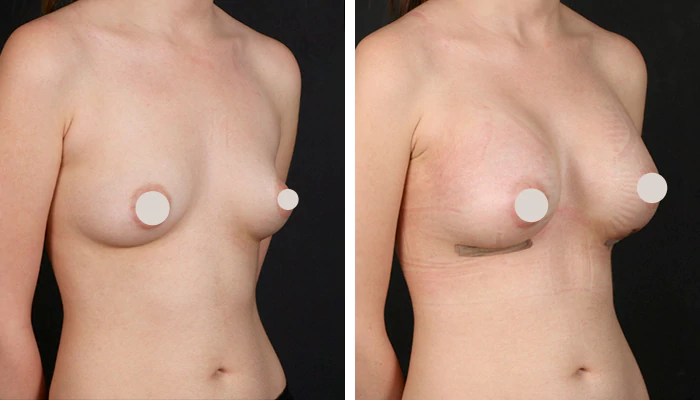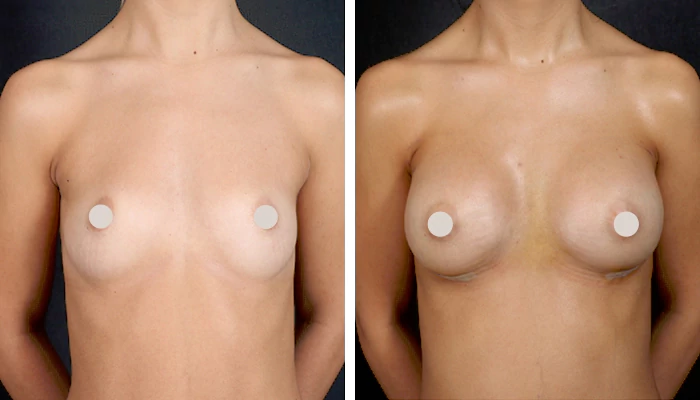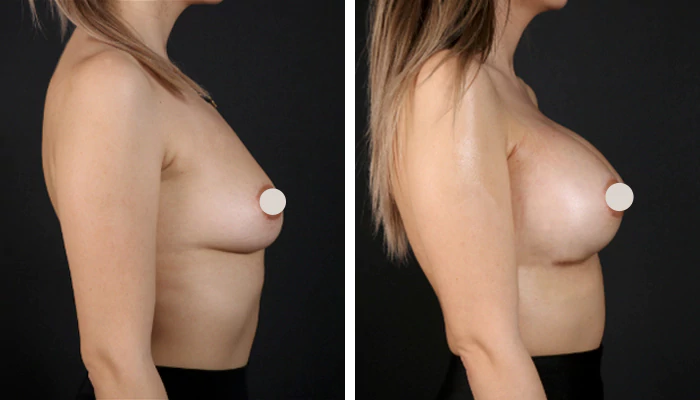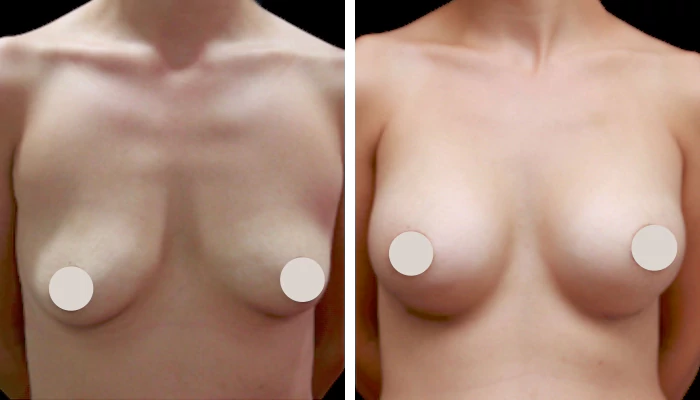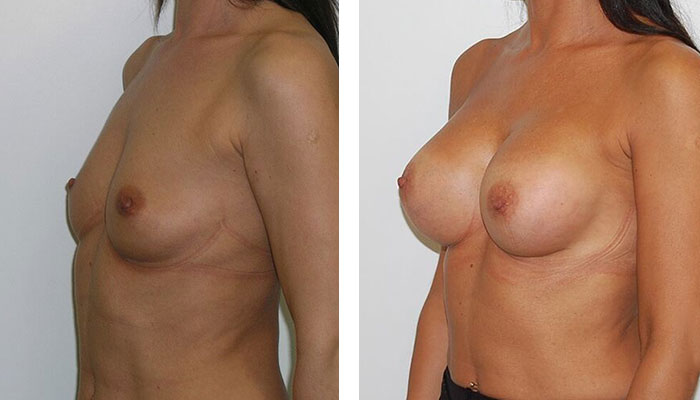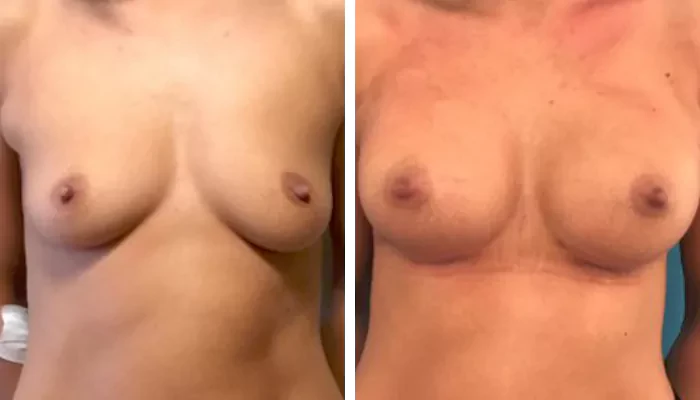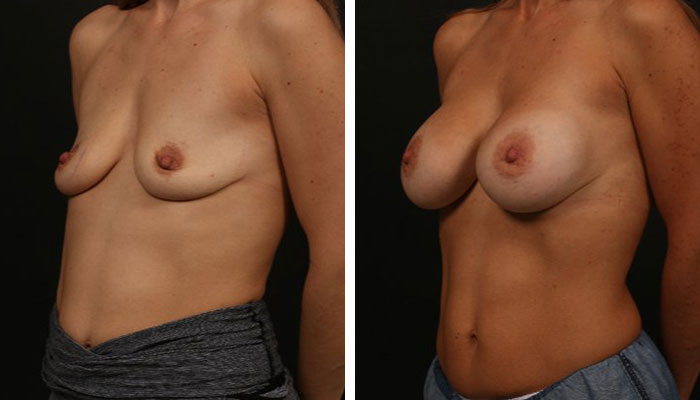What is breast implant surgery?
Breast implant surgery, also known as breast augmentation or augmentation mammaplasty and sometimes colloquially referred to as a ‘boob job’, is a cosmetic surgical procedure and the most popular type of breast augmentation that involves the insertion of implants to enhance the size, shape, and fullness of a woman's breasts. The implants are typically filled with either silicone gel or saline solution and are placed either behind the breast tissue or under the chest muscles.
The surgery is often chosen by women who wish to increase the size of their breasts, improve their breast symmetry, restore breast volume lost due to weight loss or pregnancy, or reconstruct their breasts after mastectomy. Overall, breast implant surgery can be a life-changing procedure for many women, enhancing self-confidence and body image.
Who is a suitable candidate for breast implants?
Ideal candidates for breast implant surgery are individuals who are in good overall health, have realistic expectations about the outcomes of the procedure, and are seeking to enhance the size, shape, or symmetry of their breasts. Specific characteristics of good candidates for breast implants include:
- Desire for breast enhancement: Candidates should have a genuine desire to improve the appearance of their breasts, whether to increase size, restore volume lost due to weight loss or pregnancy, correct asymmetry, or reconstruct the breasts after mastectomy.
- Good physical health: Candidates should be in good overall health and free from any medical conditions that could interfere with surgery or healing. It is essential to disclose any medical history and current medications to the plastic surgeon during the consultation.
- Emotional health: Candidates should have realistic expectations about the results of breast implant surgery and understand both the benefits and limitations of the procedure. A positive body image and mental well-being are important factors to consider.
- Stable weight: Candidates should be at a stable weight without plans for significant weight loss or gain in the future. Fluctuations in weight can affect the appearance of breast implants and may necessitate additional surgery.
- Non-smokers: Smoking can impair the healing process and increase the risk of complications during and after surgery. Candidates are typically advised to quit smoking before undergoing breast implant surgery.
- Breast development: Candidates should have fully developed breasts, as breast implants are generally not recommended for individuals whose breasts are still developing.
- Realistic expectations: Candidates should understand that breast implants are not permanent and may require maintenance or replacement over time. Open communication with the plastic surgeon about goals, concerns, and expectations is crucial.
Before considering breast implant surgery, individuals should schedule a consultation with a board-certified plastic surgeon to discuss their candidacy, goals, options, and potential risks associated with the procedure. The surgeon will evaluate the individual's anatomy and medical history to determine the most appropriate treatment plan for achieving desired results.
Different types and shapes of breast implants
Breast implants come in various types, shapes, and sizes to cater to individual preferences and aesthetic goals. The two main types of breast implants are silicone implants and saline implants. Here are the different types and shapes of breast implants available:
Silicone breast implants
Silicone implants are filled with silicone gel that closely resembles the feel of natural breast tissue. They are known for their softness and natural appearance.
Saline breast implants
Saline implants are filled with a sterile saline solution (saltwater). They are inserted empty and then filled to the desired size, allowing for adjustments during surgery.
Breast implants come in different shapes to suit individual preferences and aesthetic goals. The two main shapes of breast implants are round and teardrop (anatomical) implants.
Round implants
Round implants are symmetrical and provide fullness to both the upper and lower poles of the breast. They are versatile and can enhance cleavage.
Teardrop (anatomical) implants
Teardrop implants mimic the natural shape of the breast, with more fullness in the lower portion. They are designed to provide a more tapered and natural-looking breast contour.
Profile
Implants also come in different profiles, including low, moderate, and high. Profile refers to how far the implant projects from the chest wall, influencing the overall shape and projection of the breasts.
Texture
Implants can have a smooth or textured surface. Textured implants are designed to reduce the risk of capsular contracture by promoting tissue adherence to the implant surface.
Choosing the right type and shape of breast implants is a personal decision that should be made in consultation with a board-certified plastic surgeon. The surgeon will evaluate the patient's anatomy, discuss goals and preferences, and recommend the most suitable implants to achieve the desired aesthetic outcome.
What to expect before breast implant surgery
Before undergoing breast implant surgery, patients can expect several steps to prepare for the procedure. Here is an overview of what to expect before breast implant surgery:
- Consultation with a plastic surgeon: Patients will have an initial consultation with a board-certified plastic surgeon to discuss their goals, medical history, and expectations for breast implant surgery. The surgeon will evaluate the patient's anatomy, recommend appropriate implant options, and explain the surgical process.
- Physical examination and measurements: During the consultation, the surgeon will conduct a physical examination of the breasts, take measurements, and assess factors such as skin elasticity, breast tissue, and chest wall dimensions to determine the most suitable implant size and placement.
- Health assessment: Patients will undergo a comprehensive health assessment to ensure they are in good overall health for surgery. This may include a medical history review, laboratory tests, and possibly a mammogram or breast imaging to evaluate breast health.
- Preoperative instructions: Patients will receive specific preoperative instructions from the surgical team, which may include guidelines on medications to avoid, fasting before surgery, and arrangements for transportation to and from the surgical facility.
- Smoking and alcohol restrictions: Patients may be advised to refrain from smoking and alcohol consumption in the weeks leading up to surgery, as they can impact healing and increase the risk of complications.
- Medications: Patients may need to adjust or stop certain medications or supplements that can increase the risk of bleeding during surgery. It is important to inform the surgical team about all medications being taken.
- Preoperative preparation: Patients may be required to shower with a special antibacterial soap the night before or on the morning of surgery to reduce the risk of infection. They should also avoid wearing makeup, jewelry, and nail polish on the day of surgery.
- Arrangements for recovery: Patients should arrange for someone to drive them home after surgery and provide assistance during the initial recovery period. It is important to have a comfortable recovery space prepared with necessary supplies
By following preoperative instructions, maintaining open communication with the surgical team, and being well-prepared for the surgery, patients can help ensure a smooth and successful breast implant procedure.
What to expect during the procedure
Breast implant surgery is typically performed as an outpatient procedure under general anesthesia. Here is an overview of what to expect during the breast implant surgery procedure:
- Anesthesia administration: Before the surgery begins, the anesthesia team will administer general anesthesia to ensure the patient is comfortable and unconscious throughout the procedure.
- Incision placement: The plastic surgeon will make incisions in predetermined locations based on the patient's anatomy and implant placement preferences. Common incision sites include the inframammary fold (breast crease), periareolar (around the areola), or transaxillary (in the armpit).
- Implant placement: The surgeon will create pockets either behind the breast tissue (subglandular) or under the chest muscle (submuscular) to insert the breast implants. The choice of placement depends on factors such as implant size, patient's anatomy, and desired outcome.
- Implant insertion: The breast implants, either silicone gel or saline-filled, are carefully placed in the pockets created by the surgeon. Saline implants may be filled after insertion to achieve the desired volume, while silicone gel implants come pre-filled.
- Closure of incisions: Once the implants are positioned correctly, the surgeon will close the incisions with sutures, skin adhesives, or surgical tape. The incision closure is done meticulously to minimize scarring and promote optimal healing.
- Monitoring and recovery: After the procedure is completed, the patient will be monitored in the recovery area as they wake up from anesthesia. Vital signs will be closely monitored, and any immediate postoperative discomfort or side effects will be addressed by the medical team.
- Postoperative care instructions: Before discharge, the surgical team will provide detailed postoperative care instructions, including information on wound care, activity restrictions, pain management, and follow-up appointments. Patients are typically advised to wear a supportive surgical bra to aid in healing.
Breast implant surgery usually takes about one to two hours to complete, depending on the complexity of the procedure and any additional techniques performed. By following the surgeon's guidance and adhering to postoperative instructions, patients can help ensure a smooth recovery and optimal results from the breast implant surgery.
Recovery and aftercare
After undergoing breast implant surgery, patients need to follow postoperative care instructions to promote proper healing and achieve optimal results. Here is an overview of the recovery process and aftercare following breast implant surgery:
- Immediate postoperative period: Patients may experience some discomfort, swelling, and bruising in the first few days after surgery. Pain medication prescribed by the surgeon can help manage any discomfort. It is important to rest and avoid strenuous activities during this initial recovery period.
- Wound care: Patients should follow the surgeon's instructions for wound care, including keeping the incision sites clean and dry. Any dressings or bandages should be changed as directed, and signs of infection, such as increased redness, swelling, or drainage, should be reported to the surgical team.
- Supportive garments: Patients are typically advised to wear a supportive surgical bra or compression garment to provide support to the breasts and minimize swelling. The bra should be worn as recommended by the surgeon, usually for several weeks following surgery.
- Activity restrictions: Patients should avoid strenuous exercise, heavy lifting, and activities that strain the chest muscles for several weeks following surgery. Gradual return to normal activities can be guided by the surgeon based on individual healing progress.
- Follow-up appointments: Regular follow-up appointments will be scheduled to monitor healing progress, remove sutures if necessary, and assess the results of the surgery. It is important to attend all postoperative appointments as scheduled.
- Scar management: Proper scar care can help minimize the appearance of incision scars over time. Patients should follow the surgeon's recommendations for scar management, which may include the use of silicone gel or sheets, massage techniques, and sun protection.
- Long-term care: Breast implants are not considered lifetime devices and may require maintenance or replacement over time. Patients should continue to monitor their breast health, perform self-exams, and attend regular mammograms as recommended by healthcare providers.
- Emotional support: It is normal for patients to experience emotional ups and downs during the recovery process. Seeking support from loved ones, joining online forums or support groups, and staying in communication with the surgical team can help address any concerns or questions that arise.
By following these recovery and aftercare guidelines, patients can support a smooth recovery process, reduce the risk of complications, and achieve the desired outcomes of breast implant surgery. Open communication with the surgical team and adherence to postoperative instructions are key to a successful recovery journey.
Risks and complications
While breast implant surgery is generally safe and effective, like any surgical procedure, it carries potential risks and complications that patients should be aware of before undergoing the operation. Some of the risks and complications associated with breast implant surgery include:
- Infection: There is a risk of developing an infection at the incision site or around the implant. Signs of infection include redness, swelling, increased pain, and fever. Antibiotics may be prescribed to treat or prevent infections.
- Capsular contracture: Capsular contracture occurs when scar tissue forms around the implant, causing it to harden and potentially change the shape of the breast. Revision surgery may be required to address severe cases of capsular contracture.
- Implant rupture or leakage: Implants can rupture or leak over time, leading to changes in breast shape, size, or firmness. Silicone implant ruptures may be silent and require imaging tests to detect, while saline implant ruptures are typically more noticeable.
- Implant displacement: Implants may shift from their original placement, causing asymmetry or an unnatural appearance of the breasts. Revision surgery may be necessary to reposition the implants.
- Changes in sensation: Some patients may experience changes in nipple sensation, breast sensitivity, or numbness following breast implant surgery. These changes may be temporary or permanent.
- Scarring: Scarring is a natural part of the healing process after surgery. While efforts are made to minimize scarring, the appearance of scars can vary depending on individual healing and scar management techniques.
- Symmastia (uniboob): Symmastia occurs when the implants move too close together, creating a single “uniboob” or “breadloafing” appearance. Revision surgery may be needed to correct this condition.
- Anesthesia risks: General anesthesia carries potential risks, including allergic reactions, breathing difficulties, and adverse reactions to anesthesia medications. Anesthesia is administered and monitored by qualified professionals to minimize these risks.
- Breastfeeding challenges: Breast implants can affect the ability to breastfeed, depending on the surgical technique used and the impact on breast tissue. It is important to discuss breastfeeding concerns with the surgeon before surgery.
- Psychological impact: Some individuals may experience psychological or emotional changes following breast implant surgery, such as body image concerns, anxiety, or depression. Seeking support from mental health professionals or support groups can help address these issues.
It is important for patients to discuss these risks and potential complications with their plastic surgeon during the consultation process. By understanding the possible risks and benefits of breast implant surgery, patients can make informed decisions about their treatment and prepare for a successful surgical outcome. Regular follow-up appointments and open communication with the surgical team can help monitor and address any concerns during the recovery process.
Breast implants cost
The cost of breast implant surgery can vary depending on several factors, including the geographical location, the surgeon's experience and reputation, the type of implants used, the surgical facility, anesthesia fees, and any additional procedures performed. However, as a rough estimate, the total cost of breast implant surgery in the United States typically ranges from $5,000 to $10,000 or more. Here are some cost considerations related to breast implants:
- Surgeon's fee: The surgeon's fee typically covers the cost of the procedure, including preoperative consultations, surgical skills, and postoperative care. Surgeon fees can vary based on the surgeon's expertise and location.
- Implant type: The type of breast implants chosen (silicone gel or saline) can impact the overall cost of the surgery. Silicone gel implants tend to be more expensive than saline implants.
- Surgical facility fee: The cost of using a surgical facility, such as a hospital or an outpatient surgery center, is a factor in the total cost of breast implant surgery. Facilities with advanced equipment and amenities may have higher fees.
- Anesthesia fee: Anesthesia fees cover the cost of administering anesthesia during the procedure and monitoring the patient's vital signs. Anesthesia fees can vary based on the type of anesthesia used and the length of the surgery.
- Additional procedures: If additional procedures, such as a breast lift (mastopexy) or breast revision surgery, are performed in conjunction with breast implant surgery, they can add to the total cost of the procedure.
- Postoperative care and follow-up visits: The cost of postoperative care, including follow-up appointments, medications, and postoperative garments, should be considered when budgeting for breast implant surgery.
- Insurance coverage: In most cases, breast implant surgery is considered a cosmetic procedure and is not covered by health insurance. However, some insurance plans may cover breast reconstruction surgery following mastectomy for medical reasons.
Patients should obtain a detailed cost breakdown from the surgeon's office during the consultation process. Some plastic surgery practices may offer financing options or payment plans to help patients manage the cost of breast implant surgery. Patients should also inquire about the surgeon's credentials, experience, and patient satisfaction rates when considering the cost of the procedure.
Overall, the cost of breast implant surgery can range from several thousand dollars to upwards of tens of thousands of dollars, depending on the factors mentioned above. Patients should prioritize safety, quality of care, and the surgeon's expertise when making decisions about breast implant surgery, rather than solely focusing on cost.
What are other alternatives to breast implants?
While breast implants are a common option for enhancing breast size and shape, there are alternative methods available for individuals seeking non-surgical or implant-free approaches to breast augmentation. Some alternatives to breast implants include:
Fat transfer (autologous fat grafting)
Fat transfer or fat grafting involves harvesting fat from one area of the body (e.g., abdomen, thighs) through liposuction and injecting it into the breasts to enhance volume and contour.
The advantages of this breast augmentation technique are that it utilizes the patient's own tissue for natural-looking results, minimal scarring, and the potential for body contouring in donor areas.
On the other hand, the cons of fat transfer for breast augmentation include the limited increase in breast size compared to implants, the potential need for multiple sessions for desired results, and reabsorption of some of the injected fat over time that will affect the outcome of the procedure.
Breast lift (mastopexy)
Breast lift is a surgical procedure that involves reshaping and lifting the breasts to improve sagging, positioning, and overall appearance.
A breast lift addresses ptosis (sagging) without adding volume, improves breast symmetry and contour, and can be combined with fat transfer for enhanced results.
However, unlike breast implants and fat grafting, it does not increase breast size, and may not address volume loss.
Non-surgical options
Non-surgical treatments such as breast augmentation with fillers, injectables (e.g., hyaluronic acid), or collagen-stimulating agents may be used to add volume and improve breast appearance temporarily.
While the advantages of these treatments include non-invasiveness, shorter recovery time, and temporary results for individuals seeking subtle enhancements, the downsides are that the results are temporary and require repeat treatments, the increase in breast size is limited compared to implants, and the injectable fillers are not approved by the FDA for breast enlargement purposes.
Breast enhancement bras and garments
There are padded bras, push-up bras, silicone inserts, and breast enhancement garments designed to create the appearance of fuller, lifted breasts.
While the good points about these options are that they are non-invasive, affordable, and temporary solutions for enhancing breast size and shape, they may not be a good idea for many women because the results are temporary and dependent on wearing the garments and they are limited in providing long-term volume enhancement or correction of breast asymmetry.
When considering alternatives to breast implants, individuals should consult with a board-certified plastic surgeon to discuss their goals, preferences, and suitability for different options. The choice of breast enhancement method should be based on individual anatomy, desired outcomes, risk tolerance, and realistic expectations for results. Proper evaluation, informed decision-making, and personalized recommendations from a qualified healthcare provider can help individuals select the most suitable approach for achieving their aesthetic goals.
FAQs
Are breast implants permanent?
Breast implants are not considered permanent devices and may need to be replaced or removed at some point in the future. On average, breast implants last around 10 to 15 years before they may need to be replaced or removed.
Will breast implants leave visible scars?
Breast implant surgery typically involves incisions, which can result in scars. The extent and visibility of scars can vary depending on factors such as the surgical technique used, incision placement, individual healing process, and scar care. However, plastic surgeons strive to minimize scarring and often place incisions in discreet locations such as the natural crease under the breast (inframammary incision), around the areola (periareolar incision), or in the armpit (transaxillary incision) to help conceal scars. With proper scar care and healing, scars from breast implant surgery can fade over time and become less noticeable.
What is the best breast implant incision technique?
The best breast implant incision technique varies based on individual factors such as anatomy, implant type, desired outcome, and surgeon expertise. Patients should discuss incision options with their plastic surgeon to determine the most suitable approach for their specific needs and aesthetic goals.
How long does breast implant surgery take?
The duration of breast implant surgery can vary based on several factors, including the surgical technique, complexity of the procedure, additional procedures performed, surgeon's experience, and individual patient characteristics. On average, breast implant surgery typically takes approximately 1 to 2 hours to complete.
How to choose the right breast implant size?
The selection of the right breast implant size should be a collaborative process between you and your plastic surgeon, taking into account your unique anatomy, aesthetic goals, lifestyle considerations, and realistic expectations. By engaging in open communication, thorough evaluation, and informed decision-making, you can work together to achieve a satisfying and harmonious outcome that aligns with your goals for breast augmentation.
How soon after breast implant surgery will I be able to exercise?
Patients can typically resume light exercise and non-strenuous activities within a week after breast implant surgery. However, strenuous exercise, weightlifting, and high-impact activities should be avoided for 4-6 weeks to allow for proper healing and minimize complications.
Are silicone implants better than saline implants?
Silicone implants are often preferred for their natural look and feel, especially in thin individuals with less breast tissue. They are less likely to ripple or deflate but require regular monitoring for silent ruptures. Saline implants offer adjustability in size and prompt detection of ruptures but may feel less natural.
What happens if a breast implant ruptures?
If a breast implant ruptures, saline implants deflate rapidly with visible change, while silicone implants may have a silent rupture. Silicone leakage can stay contained or spread. Regular monitoring, imaging, and potential surgery for implant removal or replacement are essential.
Can I get my breast implants removed?
Yes, breast implants can be removed through a surgical procedure known as explantation (implant removal). Whether for medical reasons or personal choice, individuals may opt to have their implants removed.


